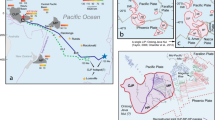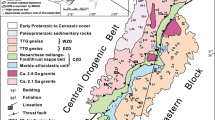Abstract
The vast Panthalassa Ocean once surrounded the supercontinent Pangaea. Subduction has since consumed most of the oceanic plates that formed the ocean floor, so classic plate reconstructions based on magnetic anomalies can be used only to constrain the ocean’s history since the Cretaceous period1,2, and the Triassic–Jurassic plate tectonic evolution of the Panthalassa Ocean remains largely unresolved3,4. Geological clues come from extinct intra-oceanic volcanic arcs that formed above ancient subduction zones, but have since been accreted to the North American and Asian continental margins4. Here we compile data on the composition, the timing of formation and accretion, and the present-day locations of these volcanic arcs and show that intra-oceanic subduction zones must have once been situated in a central Panthalassa location in our plate tectonic reconstructions5,6,7. To constrain the palaeoposition of the extinct arcs, we correlate them with remnants of subducted slabs that have been identified in the mantle using seismic-wave tomographic models8,9. We suggest that a series of subduction zones, together called Telkhinia, may have defined two separate palaeo-oceanic plate systems—the Pontus and Thalassa oceans. Our reconstruction provides constraints on the palaeolongitude and tectonic evolution of the Telkhinia subduction zones and Panthalassa Ocean that are crucial for global plate tectonic reconstructions and models of mantle dynamics.
This is a preview of subscription content, access via your institution
Access options
Subscribe to this journal
Receive 12 print issues and online access
$259.00 per year
only $21.58 per issue
Buy this article
- Purchase on Springer Link
- Instant access to full article PDF
Prices may be subject to local taxes which are calculated during checkout




Similar content being viewed by others
References
Engebretson, D. C., Cox, A. & Gordon, R. G. Relative motions between oceanic and continental plates in the Pacific Basin. Geol. Soc. Am. Spec. Pap. 206, 1–59 (1985).
Müller, R. D., Sdrolias, M., Gaina, C., Steinberger, B. & Heine, C. Long-term sea-level fluctuations driven by ocean basin dynamics. Science 319, 1357–1362 (2008).
Nur, A. & Ben-Avraham, Z. Lost Pacifica continent. Nature 270, 41–43 (1977).
Nokleberg, W. J. et al. Phanerozoic tectonic evolution of the circum-north Pacific. USGS Prof. Pap. 1626, 1–122 (2000).
Torsvik, T. H., Müller, R. D., Van der Voo, R., Steinberger, B. & Gaina, C. Global plate motion frames: Toward a unified model. Rev. Geophys. 46, 1–44 (2008).
Steinberger, B. & Torsvik, T. H. Absolute plate motions and true polar wander in the absence of hotspot tracks. Nature 452, 620–624 (2008).
van der Meer, D. G., Spakman, W., van Hinsbergen, D. J. J., Amaru, M. L. & Torsvik, T. H. Towards absolute plate motions constrained by lower-mantle slab remnants. Nature Geosci. 3, 36–40 (2010).
Amaru, M. L. Global Travel Time Tomography with 3-D Reference Models PhD thesis, Utrecht Univ. (2007).
Ritsema, J., Deuss, A., van Heijst, H. J. & Woodhouse, J. H. S40RTS: A degree-40 shear-velocity model for the mantle from new Rayleigh wave dispersion, teleseismic traveltime and normal-mode splitting function measurements. Geophys. J. Int. 184, 1223–1236 (2011).
Isozaki, Y., Maruyama, S. & Furuoka, F. Accreted oceanic materials in Japan. Tectonophysics 181, 179–205 (1990).
Shi, G. R. The marine Permian of east and northeast Asia: An overview of biostratigraphy, palaeobiogeography and palaeogeographical implications. J. Asian Earth Sci. 26, 175–206 (2006).
Golonka, J. Late Triassic and Early Jurassic palaeogeography of the world. Palaeogeogr. Palaeoclimatol. Palaeoecol. 244, 297–307 (2007).
Ueda, H. & Miyashita, S. Tectonic accretion of a subducted intraoceanic remnant arc in Cretaceous Hokkaido, Japan, and implications for evolution of the Pacific northwest. Island Arc 14, 582–598 (2005).
Stone, D. B., Minyuk, P. & Kolosev, E. New paleomagnetic paleolatitudes for the Omulevka terrane of northeast Russia: A comparison with the Omolon terrane and the eastern Siberian platform. Tectonophysics 377, 55–82 (2003).
Oxman, V. S. Tectonic evolution of the Mesozoic Verkhoyansk–Kolyma belt (NE Asia). Tectonophysics 365, 45–76 (2003).
Harbert, W. et al. Reconnaissance paleomagnetism of Late Triassic blocks, Kuyul region, northern Kamchatka Peninsula, Russia. Tectonophysics 361, 215–227 (2003).
Filatova, N. I. & Vishnevskaya, V. S. Radiolarian stratigraphy and origin of the Mesozoic terranes of the continental framework of the northwestern Pacific (Russia). Tectonophysics 269, 131–150 (1997).
Kent, D. V. & Irving, E. Influence of inclination error in sedimentary rocks on the Triassic and Jurassic apparent pole wander path for North America and implications for Cordilleran tectonics. J. Geophys. Res. 115, B10103 (2010).
Oda, H. & Suzuki, H. Paleomagnetism of Triassic and Jurassic red bedded chert of the Inuyama area, central Japan. J. Geophys. Res. 105, 25743–25767 (2000).
Uno, K., Furukawa, K. & Hada, S. Margin-parallel translation in the western Pacific: Paleomagnetic evidence from an allochthonous terrane in Japan. Earth Planet. Sci. Lett. 303, 153–161 (2011).
Matsuoka, A. Late Jurassic tropical Radiolaria: Vallupus and its related forms. Palaeogeogr. Palaeoclimatol. Palaeoecol. 119, 359–369 (1996).
Torsvik, T. H., Burke, K., Steinberger, B., Webb, S. J. & Ashwal, L. D. Diamonds sampled by plumes from the core-mantle boundary. Nature 466, 352–355 (2010).
van der Voo, R., Spakman, W. & Bijwaard, H. Mesozoic subducted slabs under Siberia. Nature 397, 246–249 (1999).
Lithgow-Bertollini, C. & Silver, P. G. Dynamic topography, plate driving forces and the African superswell. Nature 395, 269–272 (1998).
Steinberger, B. Slabs in the lower mantle—results of dynamic modelling compared with tomographic images and the geoid. Phys. Earth Planet. Int. 118, 241–257 (2000).
Kaneshima, S. & Helffrich, G. Small scale heterogeneity in the mid-lower mantle beneath the circum-Pacific area. Phys. Earth Planet. Int. 183, 91–103 (2010).
Garnero, E. J. & McNamara, A. K. Structure and dynamics of Earth’s lower mantle. Science 320, 626–628 (2008).
He, Y. & Wen, L. Structural features and shear-velocity structure of the Pacific Anomaly. J. Geophys. Res. 114, B02309 (2009).
Grand, S., van der Hilst, R. D. & Widiyantoro, S. Global seismic tomography: A snapshot of convection in the earth. GSA Today 7, 1–7 (1997).
Dickinson, W. R. & Lawton, T. F. Carboniferous to Cretaceous assembly and fragmentation of Mexico. Geol. Soc. Am. Bull. 113, 1142–1160 (2001).
Acknowledgements
D.G.v.d.M. thanks the Geological Survey of Norway for its hospitality during his sabbatical, D. Stone for the discussions on regional geology and P. Cawood, L. Liu and J. B. Murphy for reviews. Part of this work was conducted under programmes of the Vening Meinesz School of Geodynamics (Utrecht University) and the Netherlands Research Centre of Integrated Solid Earth Sciences. T.H.T. and D.J.J.v.H. acknowledge financial support from Statoil (SPlates Model project). T.H.T. acknowledges the European Research Council under the European Union’s Seventh Framework Programme (FP7/2007-2013)/ERC Advanced Grant Agreement Number 267631 (Beyond Plate Tectonics). This paper contributes to the ESF EUROCORES programme TOPO-EUROPE.
Author information
Authors and Affiliations
Contributions
D.G.v.d.M. carried out the slab identification and plate tectonic reconstruction modifications. W.S. co-developed the tomographic model. T.H.T. provided the plate tectonic reconstructions. D.J.J.v.H. provided integration between surface geology, orogenesis and subduction. M.L.A. developed the tomographic model as part of her PhD work at Utrecht University. All authors shared in writing the article.
Corresponding authors
Ethics declarations
Competing interests
The authors declare no competing financial interests.
Supplementary information
Supplementary Information
Supplementary Information (PDF 2122 kb)
Supplementary Movies
Supplementary Movies (MOV 4884 kb)
Supplementary Information
Supplementary Movies (MOV 2966 kb)
Rights and permissions
About this article
Cite this article
van der Meer, D., Torsvik, T., Spakman, W. et al. Intra-Panthalassa Ocean subduction zones revealed by fossil arcs and mantle structure. Nature Geosci 5, 215–219 (2012). https://doi.org/10.1038/ngeo1401
Received:
Accepted:
Published:
Issue Date:
DOI: https://doi.org/10.1038/ngeo1401
This article is cited by
-
Ghost-arc geochemical anomaly at a spreading ridge caused by supersized flat subduction
Nature Communications (2023)
-
Catastrophic slab loss in southwestern Pangea preserved in the mantle and igneous record
Nature Communications (2022)
-
New Permian radiolarians from east Asia and the quantitative reconstruction of their evolutionary and ecological significances
Scientific Reports (2021)
-
Surface and mantle records reveal an ancient slab tear beneath Gondwana
Scientific Reports (2019)
-
Petrogenesis of early cretaceous andesite dykes in the Sulu orogenic belt, eastern China
Mineralogy and Petrology (2019)



